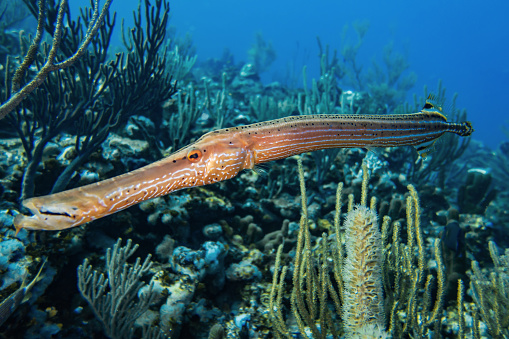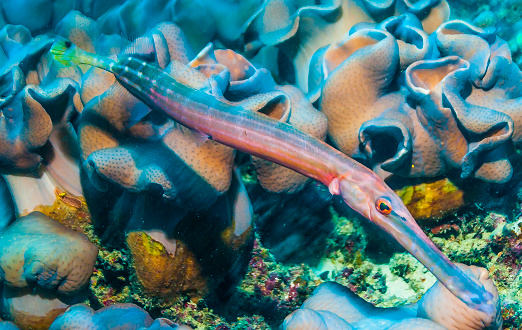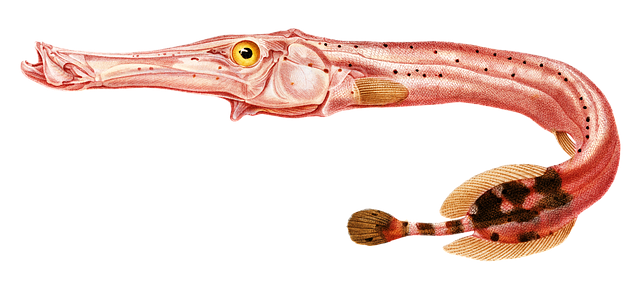The surprising story of the Chinese trumpetfish in Maldives
The Chinese trumpetfish in the Maldives is an intriguing and relatively unknown species of fish. Found primarily in the tropical waters around the Maldives, these fish are quite fascinating and their story needs to be told. This blog post will explore the unique characteristics of the Chinese trumpetfish, how they got to the Maldives, and the surprising impact they have had on the local ecosystem.
How the Chinese trumpetfish got to Maldives
The Chinese trumpetfish is a small, long, dark-blue fish that is native to the Indian Ocean, including the waters around the Maldives. In the past, it has been assumed that trumpetfish can only survive in the warm waters of the Indian Ocean, but recent research has disproved this belief. The trumpetfish found in the Maldives are thought to have migrated from its home range off the coast of mainland China.
The Maldives are an island chain located in the Indian Ocean, southwest of India. The ocean currents surrounding the Maldives range from warm and nutrient-rich to cold and nutrient-poor, and the waters are known for their unique combination of plankton, corals, and reefs. These characteristics make the area perfect for a variety of species, including the Chinese trumpetfish, which is known to inhabit tropical and subtropical reefs.

Until recently, experts believed that the Chinese trumpetfish was not able to tolerate colder temperatures or lower-oxygen waters, which are common in the deeper parts of the Indian Ocean surrounding the Maldives. However, research into the species has recently revealed that the trumpetfish can migrate long distances, sometimes up to 1300 nautical miles (nm). This dynamic behaviour means that the trumpetfish can potentially migrate from the deep-water regions of the Indian Ocean to the shallow reefs of the Maldives.
What do they eat and where do they live?
The Chinese trumpetfish (Aulostomus Chinensis) is a member of the Aulostomidae family of marine fish. It is often referred to as a “pipefish” because of its long, slender body shape and its single dorsal fin. Its unique form and vibrant colours make it an eye-catching fish, and it is commonly found in shallow coastal waters of the Indo-Pacific region. In Chinese culture, the trumpetfish is seen as a symbol of wisdom, as it is believed to have the ability to tune in to the vibrations of its environment.
The Chinese trumpetfish is a type of carnivorous fish, and it feeds on small shellfish and crustaceans. It tends to inhabit areas of coral reefs and is a popular species among recreational divers. It is well adapted to life in the ocean and can expand its body to fill up the space it inhabits, making it an ideal fish for swimming through narrow spaces.
How they are different from other fish
At first glance, this species of fish appears almost eel-like, as it ranges from eight to nearly twenty inches in length. This species is characterized by the presence of a long and large mouth that is lined with flattened, teeth – some of which are quite sharp. The most distinct feature of this fish is its dorsal fin, which provides stability but also appears like a shallow, funnel-shaped trumpet. This visual feature is unique to the Chinese trumpetfish, which respectively created its scientific name of Aulostomus Chinensis.

Coloration-wise, this species is quite varied and vibrant. Most commonly, the Chinese trumpetfish will boast bright yellow patches and dark blue streaks, though some individuals may also have green, turquoise, or black colours. Additionally, many larger specimens have red stripes running down their sides. While they typically appear while hunting, they may also change colours as a form of camouflage.
What they do during the day
The Chinese trumpetfish mainly spends its days swimming around in search of a suitable meal. Its unique body shape allows it to blend in with its environment, making it a high-speed hunter. Its eyes can move independently, enabling it to focus on smaller prey while it keeps the rest of its body concealed. It feeds mainly on small crustaceans, such as krill and shrimp, as well as small mollusks and small fish.
The Chinese trumpetfish is also an expert traveller. Its fins are designed to create thrust, allowing it to swim both forwards and backward at great speed. This, coupled with its ability to change colour, enables it to quickly and efficiently move between areas of the deep ocean and shallow coral reefs. Please keep in mind, this species is not to be confused with the more common and widely distributed California trumpetfish, which can only move forwards.
How they reproduce
Reproduction in the Chinese trumpetfish is polygonaceous and takes place in shallow, coastal waters. The breeding season usually occurs during the warmer months, typically June-August. As courtship commences, the male trumpetfish will first use its pelvic fins to create ripples in the water, then extend its pectoral fins, vibrate its body, and eventually swim in circles to attempt to lure a female.

Once a female is attracted to the display, mating can occur. The male trumpetfish may deposit milt, which contains sperm, in the water and the female will release her eggs, which the male then quickly attaches to flat objects with its long snout. Typically, the male trumpetfish will guard the eggs, spinning or swimming slowly around them in a spiral pattern. This egg-guarding behaviour may also involve the male establishing a territory and physically chasing off would-be predators, such as other fishes.
What their predators are
The Chinese trumpetfish’s unique body shape allows it to remain still without being spotted by its prey. It can be found in many different colours depending on the surrounding environment, such as gray, green, and even bright yellow. The colour of the body helps it blend in with the surrounding habitat, allowing it to easily avoid its predators while it waits for its prey. It also has two short antennae near the mouth that help it detect water movements from potential prey.
When hunting, the Chinese trumpetfish quickly extends its long snout and thrusts toward its target. This behaviour is known as “fencing” and the fish will often repeat this motion until it manages to capture its prey. The fish can expand its beak rapidly to capture its prey and can also use its tail to create a quick and sharp burst of speed. The Chinese trumpetfish is also an excellent jumper, able to rapidly leap up from the water to snag potential prey.


